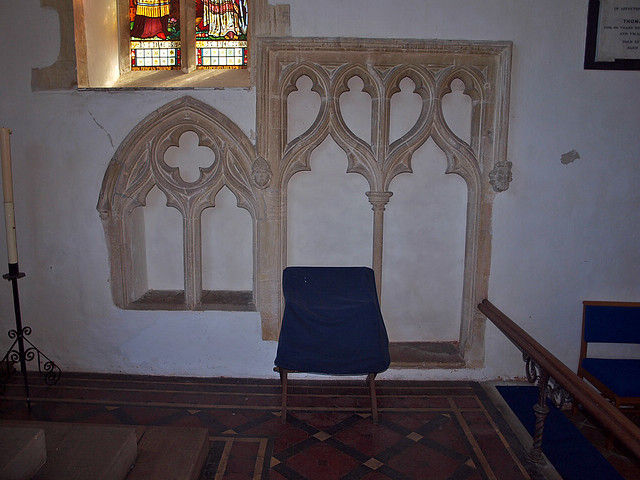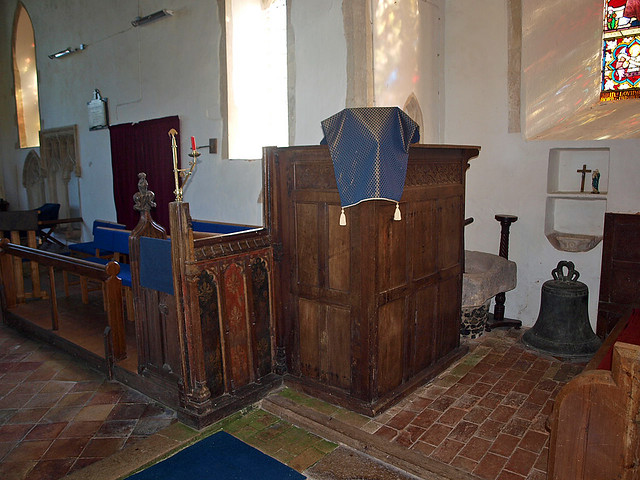ST MARY. Nave and chancel. Although there is no record of a w tower, it looks as if one has existed and disappeared. Nave windows (Y-tracery) of c.1300, chancel windows (reticulated tracery) Dec. The chancel has a separate low-side window. N porch with flushwork panelling, the upper parts damaged. (Inside the porch tunnel-vault with transverse arches. NBR) The best thing in the church is the sedilia and double piscina, two separate compositions, the latter looking earlier Dec than the former. - FONTS. Norman font from Roudham, tub-shaped with angle spurs. - Perp font on two steps, of which one is quatrefoiled. Against the stem four lions, against the bowl reliefs of the so-called Mercy Seat, the Assumption, two seated figures, and demi-figures of angels with the emblems of the Trinity and other emblems. - SCREEN. The base only, with painted ornamental motifs. - READER’S DESK. Jacobean, not, it seems in its original state, and used as a pulpit. - BENCHES. Against one end a commemorative inscription. Others complete but very dilapidated. - PAINTINGS. Moses and Aaron, C18. The Moses looks rather like a rustic version of El Greco. - STAINED GLASS. In two chancel N windows fragments of the original early C14 glass. - PLATE. Chalice (Norwich) 1567-8; also from Roudham a small Elizabethan Chalice with Paten Cover.
BRIDGHAM. It is said that on the heath near by the Danes were victorious in a battle with the Saxons; but all is peaceful now in Bridgham, where houses and farms straggle along the road, with the old church at one end among the trees, and the River Thet running through the meadows.
It is a quaint 14th-century church, with a timber bell turret and a chancel higher than the nave. Inside it is lofty and light with cream walls. The old oak bar still holds the south door, a few old glass fragments have wings, pinnacles, and leaves, and the lower part of the old screen remains. A few old benches have lost their poppyheads, but old bench-ends make up the priest’s seat, which has a rose on the arm-rest. The Jacobean pulpit looks as if it has been converted from a horsebox pew, and there is a Jacobean book-rest and a Jacobean cover crowning the old font. Though much battered the font is still fine. Lions sit round the stem and angels with outspread wings are under the bowl, which has carvings of God the Father, angels, a king, and a bishop. The bowl of an unused Norman font lies on the floor by an old cracked bell, two old friends whose work is done. The finest possession of the church is the charming group of sedilia and a double piscina, adorned with lovely tracery and with the heads of a king and a bishop.
Nearly a mile away, at Roudham, is the forlorn ruin of an old flint church standing by the thatched lodge of the hall, the tower and parts of the walls, with windows and doorways, left to tell of a fire which swept through it long ago.
It is a quaint 14th-century church, with a timber bell turret and a chancel higher than the nave. Inside it is lofty and light with cream walls. The old oak bar still holds the south door, a few old glass fragments have wings, pinnacles, and leaves, and the lower part of the old screen remains. A few old benches have lost their poppyheads, but old bench-ends make up the priest’s seat, which has a rose on the arm-rest. The Jacobean pulpit looks as if it has been converted from a horsebox pew, and there is a Jacobean book-rest and a Jacobean cover crowning the old font. Though much battered the font is still fine. Lions sit round the stem and angels with outspread wings are under the bowl, which has carvings of God the Father, angels, a king, and a bishop. The bowl of an unused Norman font lies on the floor by an old cracked bell, two old friends whose work is done. The finest possession of the church is the charming group of sedilia and a double piscina, adorned with lovely tracery and with the heads of a king and a bishop.
Nearly a mile away, at Roudham, is the forlorn ruin of an old flint church standing by the thatched lodge of the hall, the tower and parts of the walls, with windows and doorways, left to tell of a fire which swept through it long ago.



No comments:
Post a Comment